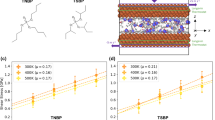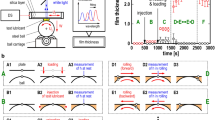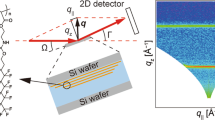Abstract
The thin film structures and tribological properties of aqueous solutions of a silicone-based amphiphilic block copolymer, bis-isobutyl polyethylene glycol (PEG)-14/amodimethicone (BIPA) copolymer, confined between mica surfaces were investigated using the surface forces apparatus. Measurements were made for three BIPA concentrations (0.005, 0.05, and 0.5 wt%); the effect of concentration on the structures and properties was evaluated. The BIPA molecules had positive charges in the solutions and formed an adsorbed layer on a negatively charged mica surface. The static hard-wall thicknesses were within the range of 3.3–5.6 nm for the three concentrations. Applying sliding motions under load L further decreased the thickness. The minimum dynamic thicknesses were 2.4–2.7 nm for the three concentrations, indicative of sliding between two adsorbed BIPA molecular layers. The friction coefficients were on the order of 10−5 for the three concentrations; extremely low friction was obtained originating from the slippage of the fluid-like water layer between the adsorbed layers. All three concentrations exhibited good lubricity, but precise comparison implies some differences in the film structures and friction mechanisms. The details of the differences were discussed from the perspective of the dissolution states of BIPA in the solutions and adsorbed/sliding conformations.
This is a preview of subscription content, access via your institution
Access options
Subscribe to this journal
Receive 12 print issues and online access
$259.00 per year
only $21.58 per issue
Buy this article
- Purchase on Springer Link
- Instant access to full article PDF
Prices may be subject to local taxes which are calculated during checkout








Similar content being viewed by others
References
Israelachvili JN. Intermolecular and surface forces. 3rd ed. Amsterdam: Academic Press; 2011.
Israelachvili J, Berman AD. Surface forces and microrheology of molecularly thin liquid films. In: Bhushan, B, editor. CRC handbook of micro/nanotribology, 2nd ed. Boca Raton: CRC Press; 1999. Chapter 9, p. 371−432.
Klein J, Kumacheva E. Confinement-induced phase transitions in simple liquids. Science. 1995;269:816–9.
Granick S. Soft matter in a tight spot. Phys Today. 1999;52:26–31.
Yamada S. General shear-thinning dynamics of confined fluids. Tribol Lett. 2002;13:167–71.
Yamada S. Structural aging and stiction dynamics in confined liquid films. J Chem Phys. 2009;131:184708/1–184708/9.
Robbins MO, Muser MH. Computer simulations of friction, lubrication and wear. In: Bhushan B, editor. Modern tribology handbook. Boca Raton: CRC Press; 2001. Chapter 20, vol 1, p. 717−65.
Klein J. Hydration lubrication. Friction. 2013;1:1–23.
Dowson D, Wright V, Longfield MD. Human joint lubrication. Biomed Eng. 1969;4:160–5.
McCutchen CW. The frictional properties of animal joints. Wear. 1962;5:1–17.
Dowson D. New joints for the millennium: wear control in total replacement hip joints. Proc Inst Mech Eng H. 2001;215:335–58.
Gong JP. Friction and lubrication of hydrogels—its richness and complexity. Soft Matter. 2006;2:544–52.
Lee S, Spencer ND. Sweet, hairy, soft, and slippery. Science. 2008;319:575–6.
Briscoe WH, Titmuss S, Tiberg F, Thomas RK, McGillivray DJ, Klein J. Boundary lubrication under water. Nature. 2006;444:191–4.
Raviv U, Klein J. Fluidity of bound hydration layers. Science. 2002;297:1540–53.
Briscoe WH. Aqueous boundary lubrication: molecular mechanisms, design strategy, and terra incognita. Curr Opin Colloid Interface Sci. 2017;27:1–8.
Cotton FA, Wilkinson G. Advanced inorganic chemistry. New York: Wiley; 1998.
Ma L, Gaisinskaya-Kipnis A, Kampf N, Klein J. Origins of hydration lubrication. Nat Commun. 2015;6:6060.
Chai L, Klein J. Interactions between molecularly-smooth gold and mica surfaces across aqueous solutions. Langmuir. 2009;25:11533–40.
Raviv U, Giasson S, Kampf N, Gohy JF, Jérôme R, Klein J. Lubrication by charged polymers. Nature. 2003;425:163–5.
Chen M, Briscoe WH, Armes SP, Klein J. Lubrication at physiological pressures by polyzwitterionic brushes. Science. 2009;323:1698–701.
Spencer ND. Aqueous Lubrication with poly(ethylene glycol) brushes. Tribol Online. 2014;9:143–53.
Briscoe WH, Klein J. Friction and adhesion hysteresis between surfactant monolayers in water. J Adhes. 2007;83:705–22.
Sorkin R, Dror Y, Kampf N, Klein J. Mechanical stability and lubrication by phosphatidylcholine boundary layers in the vesicular and in the extended lamellar phases. Langmuir. 2014;30:5005–14.
Goldberg R, Schroeder A, Barenholz Y, Klein J. Boundary lubricants with exceptionally low friction coefficients based on 2D close-packed phosphatidylcholine liposomes. Adv Mater. 2011;23:3517–21.
Banquy X, Burdyńska J, Lee DW, Matyjaszewski K, Israelachvili J. Bioinspired bottle-brush polymer exhibits low friction and Amontons-like behavior. J Am Chem Soc. 2014;136:6199–202.
Sorkin R, Kampf N, Zhu L, Klein J. Hydration lubrication and shear-induced self-healing of lipid bilayer boundary lubricants in phosphatidylcholine dispersions. Soft Matter. 2016;12:2773–84.
Chai J, Klein J. Role of ion ligands in the attachment of poly(ethylene oxide) to a charged surfaces. J Am Chem Soc. 2005;127:1104–5.
Chawla K, Lee S, Lee BP, Dalsin JD, Messersmith PB, Spencer ND. A novel low-friction surface for biomedical applications: modification of poly(dimethylsiloxane) (PDMS) with polyethylene glycol (PEG)-DOPA-Lysine. J Biomed Mater Res A. 2009;90A:742–9.
Tadmor R, Chen N, Israelachvili J. Normal and shear forces between mica and model membrane surfaces with adsorbed hyaluronan. Macromolecules. 2003;36:9519–26.
Lee DW, Banquy X, Israelachvili JN. Stick-slip friction and wear of articular joints. Proc Natl Acad Sci USA. 2013;110:E567–E574.
Andresen Eguiluz RC, Cook SG, Brown CN, Wu F, Pacifici NJ, Bonassar LJ, et al. Fibronectin mediates enhanced wear protection of lubricin during shear. Biomacromolecules. 2015;16:2884–94.
Miyamoto T, Yamazaki N, Watanabe S, Yamada S. Aqueous lubrication with the molecularly confined films of silicone-based amphiphilic block copolymer aggregates. Langmuir. 2019;35:15784–94.
Miyamoto T, Yamazaki N, Tomotsuka A, Sasahara H, Watanabe S, Yamada S. Tribological properties between taut hair fibers in wet conditions: a new shampoo formulation for eliminating stick-slip friction. J Surf Deterg. 2021;24:501–10.
Israelachvili JN, McGuiggan PM. Adhesion and short-range forces between surfaces. Part I: New apparatus for surface force measurements. J Mater Res. 1990;5:2223–31.
Luengo G, Schmitt FJ, Hill R, Israelachvili J. Thin film rheology and tribology of confined polymer melts: contrast with bulk properties. Macromolecules. 1997;30:2482–94.
Horn RG, Israelachvili JN. Molecular organization and viscosity of a thin film of molten polymer between two surfaces as probed by force measurements. Macromolecules. 1988;21:2836–41.
Yamada S. Layering transitions and tribology of molecularly thin films of poly(dimethylsiloxane). Langmuir. 2003;19:7399–405.
Yamada S. Nanotribology of poly(dimethylsiloxane) melt confined between hydrophobic surfaces. Tribology Online. 2006;1:29–33.
Xu R, Winnik MA, Riess G, Chu B, Croucher MD. Micellization of polystyrene-poly(ethylene oxide) block copolymers in water. 5. A test of the star and mean-field models. Macromolecules. 1992;25:644–52.
Nicolai T, Colombani O, Chassenieux C. Dynamic polymeric micelles versus frozen nanoparticles formed by block copolymers. Soft Matter. 2010;6:3111–8.
Zeng H, Maeda N, Chen N, Tirrell M, Israelachvili J. Adhesion and friction of polystyrene surfaces around Tg. Macromolecules. 2006;39:2350–63.
Benz M, Gutsmann T, Chen N, Tadmor R, Israelachvili J. Correlation of AFM and SFA measurements concerning the stability of supported lipid bilayers. Biophy J. 2004;86:870–9.
Acknowledgements
We are grateful to Prof. Shin-ichi Yusa of the University of Hyogo for his useful suggestion, to Taichi Habe of Kao Corporation for supporting AFM experiments, and to Kao Corporation for permission to publish this paper.
Author information
Authors and Affiliations
Corresponding author
Ethics declarations
Conflict of interest
The authors declare no competing interests.
Additional information
Publisher’s note Springer Nature remains neutral with regard to jurisdictional claims in published maps and institutional affiliations.
Rights and permissions
About this article
Cite this article
Kimura, H., Miyamoto, T., Yamazaki, N. et al. Boundary lubrication with aqueous solutions of silicone-based amphiphilic block copolymer aggregates: effect of concentration. Polym J 53, 1123–1132 (2021). https://doi.org/10.1038/s41428-021-00515-w
Received:
Revised:
Accepted:
Published:
Issue Date:
DOI: https://doi.org/10.1038/s41428-021-00515-w



